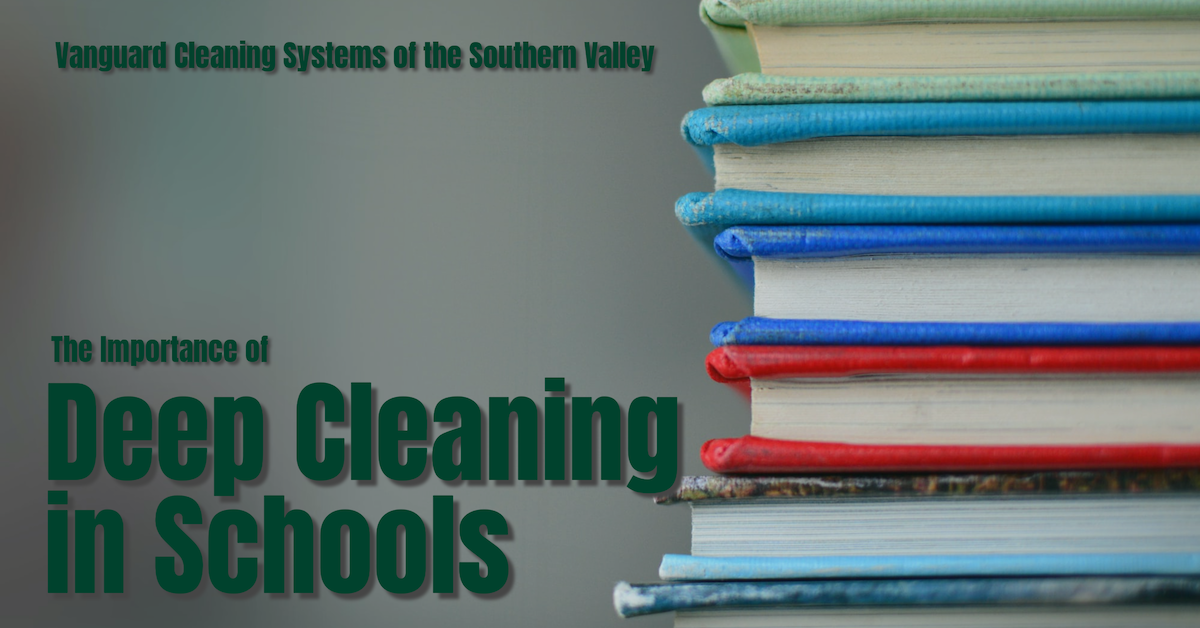Deep cleaning education facilities is more than just a surface-level endeavor; it is a comprehensive approach to improving health, safety, and overall well-being.

Understanding Deep Cleaning in Education Facilities
Deep cleaning encompasses comprehensive sanitation measures that surpass routine maintenance activities like dusting, sweeping, and mopping.
Its scope encompasses meticulously cleansing all surfaces, including those typically neglected, such as ceiling fans, light fixtures, and baseboards.
In educational establishments, it is imperative to schedule regular deep cleaning sessions, particularly during periods of heightened susceptibility to illnesses, such as the winter season or a contagious disease outbreak.
Why Deep Cleaning in the Classroom Matters
According to the U.S. Department of Education, classrooms should be cleaned;
[...] at least once a day to sufficiently remove any germs that may be on surfaces. [1]
According to a 2022 paper published in the Journal of Exposure Science & Environmental Epidemiology, routine enhanced classroom cleaning positively impacted detectable contaminant levels on classroom desktops, resulting in decreased reported absences due to gastrointestinal issues.
We found that enhanced cleaning protocol, including bi-weekly cleaning of classroom desks, as well as training of custodians and teachers, monitoring of effectiveness, and feedback, yielded a moderate but statistically significantly lower level of biocontamination on desktops, indicated by quantitative ATP monitoring.
Within the range of weekly average desktop ATP levels observed, the probability of reported absence due to gastrointestinal illness is estimated to increase from 0.021 to 0.026.
Based on the results, enhanced surface cleaning and monitoring its effectiveness is a possible district, state, or even national-level policy to support healthy school environments. [2]
The Case for School Break Deep Cleaning Services
Utilizing extended student breaks, schools can capitalize on the opportunity to engage in comprehensive deep cleaning operations, resulting in the maintenance of pristine surfaces, enhanced health and safety measures, minimized long-term repair expenses, and the transmission of a nurturing message to students, staff, and the community.
During this time, assessments should be conducted to identify potential pathogen presence, necessitating the implementation of cleaning practices to eradicate them.
A meticulous plan should be devised, encompassing the required equipment and supplies for deep cleaning various rooms/areas, focusing on health offices, gymnasiums, athletic equipment, and places frequented by young children and disabled students.
Indoor Air Quality (IAQ) must also be addressed, as indoor pollutant levels, as per the Environmental Protection Agency (EPA), often exceed outdoor levels by a factor of two to five, and sometimes even by over 100 times.
Measures such as washing windows, detailing light fixtures, relocating furniture for a thorough cleaning, and implementing deep cleaning processes for carpeted surfaces can eliminate airborne pollutants, benefiting individuals with allergies and asthma.
In addition, the deep cleaning of refrigerators and freezers should be undertaken to eliminate frost and expired food items.
At the same time, HVAC systems should be subject to deep cleaning procedures to eliminate pollutants, dust, and mildew, thereby enhancing IAQ and ensuring optimal operation for occupants' comfort. [3]
References
How to Prioritize the Health and Safety of Students, School Personnel, and Families | U.S. Department of Education. (n.d.). https://sites.ed.gov/backtoschool/health-safety/
Shaughnessy, R., & Hernandez, M. (2022). Effects of classroom cleaning on student health: A longitudinal study. Journal of Exposure Science & Environmental Epidemiology, 32(5), 767-773. https://doi.org/10.1038/s41370-022-00427-8
School Break Deep Cleaning. (n.d.). Retrieved June 21, 2023, from https://www.mtsac.edu/risk/documents/Safety-Spotlight-School-Break-Deep-Cleaning-Dec-2019.pdf
Takeaway
Deep cleaning in education facilities goes beyond routine maintenance, including sanitizing and sanitizing all surfaces, including those typically neglected.
This is especially important during periods of heightened susceptibility to illness, such as the winter season or a contagious disease outbreak.
Recent studies have found that enhanced cleaning protocol, including bi-weekly cleaning of classroom desks, yielded a moderate but statistically significantly lower level of biocontamination on desktops, indicated by quantitative ATP monitoring.
During school breaks, schools can capitalize on the opportunity to engage in comprehensive deep cleaning operations, resulting in the maintenance of pristine surfaces, enhanced health and safety measures, minimized long-term repair expenses, and the transmission of a nurturing message to students, staff, and the community.
Outsourcing is a proven method for onboarding highly in-demand cleaning and sanitization services and experience for a fraction of the price of maintaining a similar service in-house.
If you would like more information regarding the effectiveness of high-performance infection prevention and control measures, or if you would like to schedule a free, no-obligation on-site assessment of your facility's custodial needs, contact us today for a free quote!
In Bakersfield, CA, call (661) 437-3253
In Fresno, CA, call (559) 206-1059
In Valencia, CA, or Santa Clarita, CA, call (661) 437-3253
In Palmdale, CA, or Lancaster, CA, call (661) 371-4756

